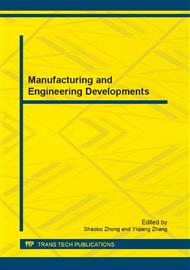p.86
p.91
p.97
p.105
p.111
p.115
p.119
p.124
p.129
A Study on Elevator of Li-Ion Power Battery Formation Equipment
Abstract:
As a new type of energy of large-capacity and high-power, li-ion power battery is widely used in many fields such as energy storage, uninterruptible power system, mobile communications, electric toys, etc. At present, traditional human-based detection methods are mainly adopted in the detection process of battery formation, which to some extent exerts pressure on the cost of human resources and management of lithium battery enterprise. In order to solve this problem, this paper puts forward an elevator scheme applied to formation detection line. The elevator is used to control the battery pack’s movement in the vertical direction and the horizontal direction. The scheme reduces the labor intensity of detection work in the production line. The elevator system has been applied to formation detection lines now, and achieved good economic benefits.
Info:
Periodical:
Pages:
111-114
Citation:
Online since:
January 2013
Keywords:
Price:
Сopyright:
© 2013 Trans Tech Publications Ltd. All Rights Reserved
Share:
Citation:


